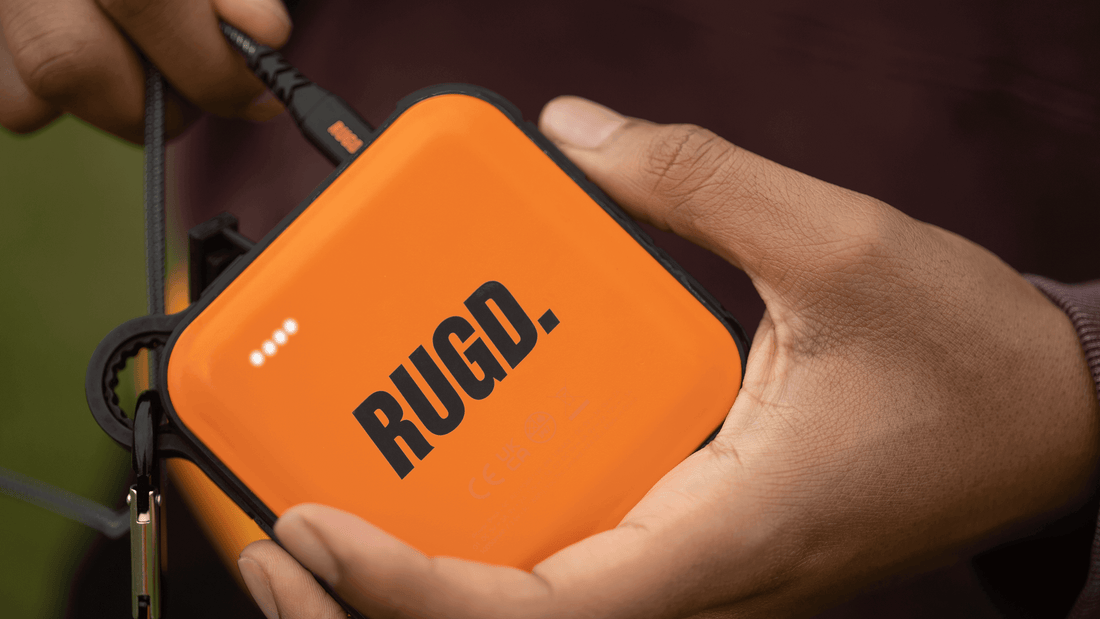
Maximising Power Bank Battery Life: Your Guide to Getting the Most Out of Your RUGD Power Brick
Share
Ever had your power bank die right when you need it most? You're not alone. Learning how to keep power bank healthy is essential for anyone who relies on portable power, whether you're hiking in the Lake District or simply commuting through London.
The good news? Keeping your power bank in tip-top condition isn't rocket science. With the right maintenance habits, you can significantly extend its lifespan and ensure it's always ready when you need it most.
Quick Answer: Keep your power bank healthy by charging between 20-80%, storing in cool dry places, using regularly, and avoiding extreme temperatures. These simple practices can extend battery life by up to 50%.
Why This Guide Matters
- Save money by extending power bank lifespan
- Ensure reliable power when you need it most
- Avoid the frustration of dead batteries
- Maximise your investment in quality gear like the RUGD Power Brick
Understanding Your Power Bank's Inner Workings
What's Inside Your Power Bank?
Most modern power banks, including the robust RUGD Power Brick, use lithium-ion or lithium-polymer batteries. These are the same technology powering your smartphone and laptop.
Understanding this helps you realise why proper care matters - these batteries have a finite number of charge cycles before they start losing capacity.
The Charge Cycle Reality
Every power bank has approximately 300-500 full charge cycles before noticeable capacity loss begins. But here's the kicker - you can significantly extend this with proper care.
Think of it like maintaining a car - regular servicing keeps it running longer and better.
Key Insight
The way you charge, store, and use your power bank has a massive impact on its lifespan. Small changes in habits can add years to your device's life.
How to Keep Power Bank Healthy: 8 Essential Practices
1. Master the Art of Smart Charging
Golden Rule: Keep your power bank between 20% and 80% charge for optimal health
Do This:
- Charge to 80% maximum for daily use
- Start charging when it hits 20%
- Use the original charger or quality alternatives
- Unplug once fully charged
Avoid This:
- Charging to 100% regularly
- Letting it drain completely
- Using cheap, uncertified chargers
- Leaving it plugged in overnight
RUGD Power Brick Tip: The dual-port charging feature lets you optimise charging speeds. Use USB-A for regular charging and USB-C PD only when you need quick power boosts.
2. Store Like a Pro
Where and how you store your power bank significantly impacts its longevity. Here's how to keep power bank healthy during storage:
- Temperature Control: Store between 0°C-25°C for optimal battery health
- Dry Environment: Keep away from moisture and humidity
- Shade Protection: Avoid direct sunlight and heat sources
Long-Term Storage Checklist:
- Charge to 50% before storing
- Check and recharge every 3 months
- Store in original case or protective pouch
- Keep away from metal objects
3. Use It or Lose It
Here's something many people don't realise: regular use actually keeps your power bank healthier. Batteries that sit unused for months can lose their ability to hold charge effectively.
Monthly Maintenance Routine
- Use your power bank at least once per month
- Run a complete charge/discharge cycle
- Check all ports for dust or debris
- Test charging speed and capacity
Warning Signs to Watch For
- Takes much longer to charge devices
- Gets unusually hot during use
- LED indicators don't work properly
- Physical swelling or damage
4. Master Temperature Control
Temperature Danger Zones
Too Hot (Above 35°C):
- Car dashboards in summer
- Direct sunlight
- Near radiators or heaters
- Charging while in hot environments
Too Cold (Below 0°C):
- Outdoor winter activities
- Unheated storage areas
- Car boot in winter
- Freezer compartments
RUGD Power Brick Advantage
The RUGD Power Brick's IP67 certification provides excellent protection against environmental factors, but it's still wise to avoid extreme temperatures for optimal battery health.
5. Choose Quality Equipment
Not all power banks are created equal. Investing in quality like the RUGD Power Brick means built-in safety features and longer lifespan.
- Overcharge protection
- Short circuit prevention
- Temperature monitoring
6. Handle with Care
Physical damage can compromise internal components and safety features.
- Avoid drops and impacts
- Use protective cases
- Keep ports clean
7. Smart Cable Management
The cables you use matter just as much as the power bank itself.
- Use quality cables
- Check for fraying regularly
- Match cable specs to device needs
8. Monitor Performance
Keep track of your power bank's performance to catch issues early.
- Note charging times
- Monitor device charging speed
- Check LED indicators
Maximising Your RUGD Power Brick's Potential
Key Features for Longevity
- Dust & Water Resistance: Protects internal components from environmental damage
- Battery Indicators: Helps prevent overcharging by showing exact charge level
- 1300 Lumen Light: Multiple brightness modes to conserve power when needed
Optimised Usage Tips
Dual-Port Strategy
Use USB-A for regular charging (gentler on battery) and USB-C PD for emergency quick charges only.
SOS Light Management
Adjust brightness based on need - lower settings preserve battery while still providing essential light.
Adventure Ready
The carabiner and rugged design mean it can handle outdoor conditions without compromising battery health.
Ready to Experience Premium Power?
The RUGD Power Brick combines rugged durability with intelligent design for maximum battery longevity.
5 Common Mistakes That Kill Power Banks
1. The "Always 100%" Mistake
Constantly charging to 100% creates stress on lithium batteries, reducing their lifespan significantly.
Fix: Charge to 80% for daily use, 100% only when you need maximum capacity.
2. The Car Dashboard Storage
Leaving power banks in cars exposes them to extreme temperatures that can permanently damage batteries.
Fix: Always take your power bank with you or store in temperature-controlled environments.
3. The "Set and Forget" Approach
Storing power banks for months without use leads to deep discharge and potential permanent damage.
Fix: Use your power bank monthly and check stored units every 3 months.
4. Cheap Charger Chaos
Using low-quality chargers can deliver inconsistent power, causing overheating and battery damage.
Fix: Invest in quality chargers from reputable brands - it's cheaper than replacing power banks.
5. Ignoring Warning Signs
Continuing to use power banks that get unusually hot, charge slowly, or show physical damage.
Fix: Stop using immediately if you notice swelling, excessive heat, or performance issues.
Frequently Asked Questions
How often should I use my power bank to keep it healthy?
Use your power bank at least once per month to maintain battery health. If you don't need to charge devices, run a simple charge/discharge cycle to keep the battery active. This prevents the deep discharge that can occur during long periods of inactivity.
Is it bad to leave my power bank charging overnight?
While modern power banks like the RUGD Power Brick have overcharge protection, it's still best practice to unplug once fully charged. Continuous charging can generate heat and stress the battery unnecessarily, potentially reducing its lifespan over time.
Can I use my power bank while it's charging?
It's generally safe with quality power banks, but it can generate extra heat and slow down the charging process. For optimal battery health, it's better to let your power bank charge completely before using it to charge other devices.
What's the ideal charge level for long-term storage?
Store your power bank at approximately 50% charge for long-term storage. This level minimises battery stress while ensuring enough power to prevent deep discharge. Check and recharge every 3 months during extended storage periods.
How do I know if my power bank needs replacing?
Replace your power bank if it: takes significantly longer to charge devices, gets unusually hot during use, has visible swelling or damage, holds less than 60% of its original capacity, or if charging indicators don't function properly.
Does cold weather affect power bank performance?
Yes, cold temperatures can temporarily reduce battery capacity and charging speed. Keep power banks close to your body in cold conditions and allow them to warm to room temperature before charging. Avoid storing below 0°C for extended periods.
Should I always use fast charging on my power bank?
Fast charging is convenient but can generate more heat and stress the battery. Use it when needed, but opt for standard charging speeds for regular use. The RUGD Power Brick's dual ports let you choose the appropriate charging speed for each situation.
How long should a quality power bank last?
A well-maintained, quality power bank should last 3-5 years with regular use. Following proper care practices can extend this significantly, while poor maintenance habits can reduce lifespan to just 1-2 years.
Keep Your Power Bank Healthy for Years of Reliable Service
Learning how to keep power bank healthy isn't complicated, but it makes all the difference between a device that serves you reliably for years versus one that disappoints when you need it most.
Your Quick Action Plan
Daily Habits:
- Charge between 20-80%
- Avoid extreme temperatures
- Use quality cables
- Handle with care
Monthly Maintenance:
- Use your power bank at least once
- Clean ports and check for damage
- Test charging performance
- Check stored units if applicable
Whether you're using a rugged RUGD Power Brick I for outdoor adventures or any other quality power bank, these maintenance principles will help you get the maximum value from your investment.
Remember: A well-maintained power bank is your reliable companion for years, while a neglected one becomes expensive electronic waste.
Ready to upgrade to a power bank built for adventure?


